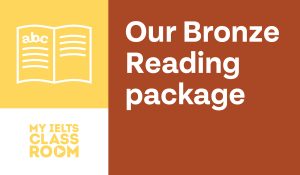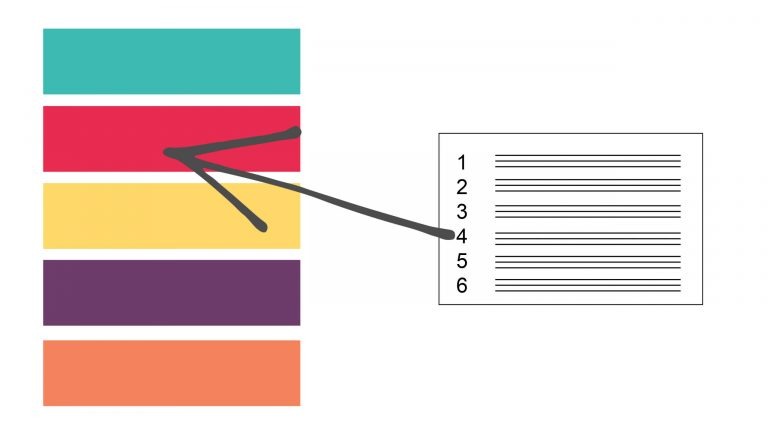
IELTS General Training Reading Multiple Matching
IELTS General Training Reading Multiple Matching
You know how some people like to relax by doing a crossword puzzle of a sudoko? Well, my ideal way to unwind would be doing dozens and dozens of IELTS General Training Reading Multiple Matching questions! You may think that I am joking, but I am 100% serious! Of all the IELTS reading questions, they are by far my favourite as they are quick and easy to complete and it is always clear when you have found the correct answer. So, join Nick and I today as we look at the three types of multiple matching questions to show you how you can master them.
Below, you can find a summary of the episode, which includes all of the links to useful materials and the times of each part of the discussion (so you can go directly to the part you want to listen to) 🚀
Subscribe to My IELTS Classroom podcast on Apple podcasts here
Subscribe to My IELTS Classroom on Google podcasts here
Introduction: It is still hot and the Olympics are coming!
Nick and I are struggling to cope in temperatures of 30 degrees+ and the Olympic games are about to start in Tokyo!
IELTS General Training Reading Multiple Matching: The Basics
- You are given a number of short texts (usually 4 – 7) that describe similar products or places. These are usually reviews of places you might visit or stay in if you travelled to an English speaking country (hotels, day-trip destinations, museums, or castles) or descriptions of items that you might buy (suitcases, watches, wallets, keyboards, rice cookers!)
- You are also given a number of statements, or characteristics that you have to match to ONE of the texts. For example, if you are given the description of 5 castles, you may be asked to find the castle that gives discounts for children.
- There is only ever ONE correct answer, but there will be distractors – for example, 2 or 3 of the descriptions of castles may mention discounts, but only ONE will mention discounts for children.
- Some texts will match to more than one question.
- There is a possibility that one text will not match to any
- These questions test VOCABULARY
How IELTS General Training Reading Multiple Matching Questions Work
These questions are designed to test your ability to read product reviews or advertisements in the real world. Imagine, for example, that you want to buy a new suitcase. As you are looking through Amazon (or any other another online store!), you would likely discover that all bags have similar features – the size, the material that it is made out of, the number of pockets, the type of handle, and whether or not it has wheels. You may also find, if you are reading the customer reviews, that some bags function better than others – maybe some are difficult to pull, or they damage easily, or they are not waterproof.
These are things that you would need to identify and compare when making your purchase choice. Now let’s look at the IELTS General Training Reading Multiple Matching question from Cambridge 14, Test 1, that asks us to match these features to five suitcases:

You can see that the “features” are very similar to those that we would compare in the real world! In other words, IELTS is simply checking if you are able to read simple descriptions or reviews in the real world
We are the CLB9 and 10 experts. Find out how we can help you shorten your path to Canada here

Why do I need to understand what this type of question tests?
Well, once you understand what IELTS General Training Reading Multiple Matching questions are checking, you can hopefully understand the right way to approach them. For example, Question 7 above asks you to identify the paragraph that tells us:
- The zips on this cabin bag may be difficult to use
Do you think that just one of the cabin bags will have zips, or do you think all of them will? My guess is that at least three of the cabin bags will have zips (as almost ALL bags in real life share this feature). This means that
you cannot just scan for the word “zips” to find the answer to 7 as you will find “zips” in more than one paragraph
Remember! We are not just looking for “zips”! We are looking for “zips that are difficult to use”.
Plus, do you think that you will read the words “difficult to use” in just one of the paragraphs? Of course you won’t – that would be far too easy! IELTS General Training Reading Multiple Matching questions are essentially a test of your vocabulary, so in order to find the correct answer
you will need to find a paraphrase of “difficult to use”
Let’s see how this works in practice. I have underlined all of the times that “zips” are mentioned in the paragraphs. I want you to tell me which paragraph contains the answer for 7 i.e. which paragraphs tell us that the cabin bag has “zips that are difficult to use” (you can hear the answer in the podcast!)
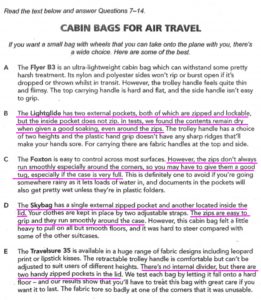
What makes IELTS General Training Reading Multiple Matching questions even more difficult?
To make matters worse, IELTS does not just mention the feature or function that you are checking in more than one paragraph, it will also use the key checking words in the questions in other descriptions to confuse you! Take question 14 for example. It asks you to identify the paragraph that tells us:
- The trolley handle of this cabin bag is adjustable
We have just seen that it will not be possible to simply scan for “handle” to find the answer. However, you should also NOT try to scan for the word “adjustable” to find the answer. Sure, you will be able to find the word somewhere in the passage, but I am 99% confident that it will NOT be in the paragraph that contains the answer! This is other “trick” that IELTS uses with these questions –
they use the key words but only with the wrong answer!
Again, look at the text. I have underlined all of the times the words “handle” and “adjustable” (or a form of the word adjustable) has been used. Which paragraph contains the right answer?

The word “adjustable” is used in Paragraph C but this is to describe the internal straps not the handle (so it is not the correct answer). It is also used in Paragraph E, where we are old that they handles can’t be adjusted (so that is not the right answer). The correct answer is in fact B, where there is NO MENTION of the word “adjustable”! Instead, we have a paraphrase “the trolley handle has a choice of two heights“. Once again, this is not a difficult question as long as you remember that
we are not matching key words – we are matching MEANING!
IELTS General Training Reading Multiple Matching questions that focus on experiences and reviews
Multiple matching questions do not always focus on comparing products. They can also target “experiences” such as visits to museums or castles, or “reviews” or a particular hotel or course. The basic skills needed to tackle these questions are the same (i.e., we will focus on matching meaning and looking for paraphrases or synonyms) but there are some new challenged introduced. In the episode, Nick and I will look at these two questions to show you the small but important differences:
Comparing museums “experiences”
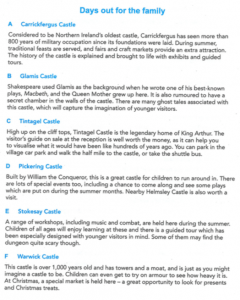
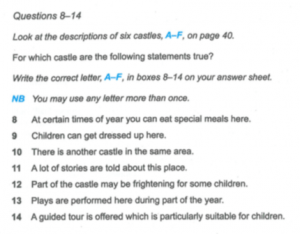
Comparing hotel “reviews”
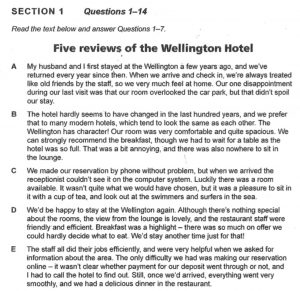
The best way to approach IELTS General Training Reading Multiple Matching questions
There are two ways that you can approach IELTS General Training Reading Multiple Matching questions. Neither is “better” as they can both lead you to all of the right answers, but I do think think that you should consider your language level (intermediate or advanced) and the type of question (comparing products, comparing experiences, or comparing reviews).
1. Focus on the questions (best for high-level students and comparing “products”)
This is the way that Nick and I have been tackling the items in the podcast today. We take a question, for example “The zips on this cabin bag may be difficult to use” and then scan each paragraph looking for “zips” and their description until we find one that 100% matches the phrase we are looking for. If you are a native speaker or a high-level student, then this can be a fast and efficient approach.
However, BE CAREFUL! As we saw in the episode, for more difficult items, the paraphrase in the passage may have NONE of the words from the task, so answers can be easily missed. Also, you will need to be very careful that the answer you find 100% matches the question asked – remember how close “Christmas for treats” is to “Summer for feasts”! You can easily choose the wrong answer if you are just scanning!
Struggling with Headings Match questions? Then listen to our episode about the best way to tackle these questions here (Spoiler – you will have to read more than the first and last lines!)
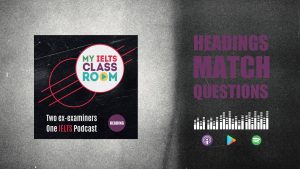
2. Focus on the paragraphs (best for lower-level students and comparing “experiences” or “reviews”)
Honestly, this is the method that I would recommend to all but the highest-level students. As we have seen, we cannot rely on scanning for key words as what we are matching is meaning. That means the safest (and actually the most time-efficient) way to answer these questions is to read through each paragraph sentence by sentence.
Every sentence will target one of the questions, so all you have to do is read each sentence in turn, check if it is a match or a distractor, and then move forward to the next sentence. Using this method will take a little bit of extra time at the start, but as you move through the paragraphs it becomes quicker and quicker as you have fewer and fewer questions to check. Also, it teaches you to recognise distractors and will ensure you don’t fall for any tricks!
Let’s look at this first paragraph as an example:
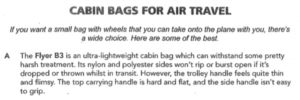
If you read the first two sentences, you will recognise that they are talking about how easily damaged the bag can be. This looks like it could be the answer to question 8 “This cabin bag maybe badly damaged if it is dropped”.
However, we are not simple students who have paid IELTS $200 to fall for their tricks! We are highly trained IELTS assassins who recognise immediately that the sentence in A gives us totally the OPPOSITE information despite using the key word “dropped”
“It’s nylon and polyester sides won’t burst open if it is dropped or thrown whilst in transit”
Therefore, we will recognise this as a distractor, laugh to ourselves that IELTS thinks it can trick us so easily, and then move to the next sentence! Here, we will find two sentences about the handles, which we will read carefully, and (as discussed in the podcast) recognise as the answer to 9. In working through the paragraphs in this way, you will find that every sentence or pair of sentences in these questions is written to be either an answer or a distractor for another question.
Once you know this, it is easy to confirm or dismiss each as long as you read carefully and match the meaning.
Would you like expert help to improve your IELTS reading score?
We offer a 5-day intensive course for IELTS test-takers every month that covers all aspects of reading from how to approach every type of question to how to “read one, read well” to manage your time more effectively. Even better, with every course having no more than 8 students and being run by an ex-examiner, you will be getting personalised advice that is guaranteed to help you to improve your score.
Find out more about the course and how it can help you hit your target score here.
